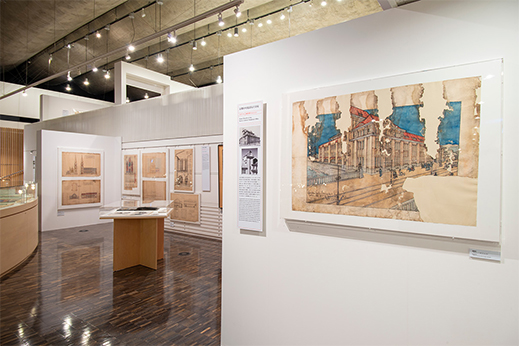 |
Focus features two in-depth reviews each month of fine art, architecture and design exhibitions and events at art museums, galleries and alternative spaces around Japan. The contributors are non-Japanese residents of Japan. |
|
|
 |
 |
 |
The Pioneering Spirit of Tetsuro Yoshida: Leading an Era of Change in Japanese Architecture
James Lambiasi |
 |
Installation view, entry to the exhibition.
|
Occasionally a pioneering movement in architecture can have such a profound effect that its popularity leads to it becoming ubiquitous and we actually lose sight of its reactionary roots. Modernist architecture could be described in this way, in that it revolutionized traditional building methods with steel, glass, and reinforced concrete, and subsequently turned functionalism and minimalism into the basic staples of our contemporary architectural vocabulary. As a consequence, perhaps we tend to forget that many of the structures we encounter in our daily lives actually owe their existence to architects who had a great passion for revolutionizing traditional ways.
Fortunately, we are now able to understand the achievements of one such architect through an exhibition highlighting the life work of Tetsuro Yoshida (1894-1956), a pioneer of modern architecture in Japan. The National Archives of Modern Architecture, run by the Japanese government's Agency for Cultural Affairs, combines an extensive collection of his sketches, plan drawings, and models in its current exhibition, Yoshida Tetsuro: Bridging Modernism and Tradition. The show presents a comprehensive chronicle of Yoshida's work, covering in separate sections his early period including when he was a student, his innovative work in residential architecture, his pioneering efforts as an architect for the Ministry of Communications, and his pursuit of modern design particularly in his interactions abroad.
 |
|
Installation view with perspective drawing of the Kami Branch of the Kyoto Central Telephone Office. Ink and color on paper (1922.2.8). |
Detail drawing of the Kami Branch of the Kyoto Central Telephone Office. Ink and color on washi paper and tape. Courtesy of NTT Facilities |
The first section of the show introduces Yoshida as a talented young architect, producing works that exhibit a deft ability to create both Japanese traditional detail and architectural styles of Western influence. One of his early works is the Kami Branch of the Kyoto Central Telephone Office. In this building, Yoshida accommodated the steeply pitched roofs and bow-shaped dormer windows typical of North German vernacular homes. What is interesting, however, is that he combined these with roof tiles, eaves, and pilasters in order to harmonize the building with its Kyoto setting. Even at this early stage in his career, Yoshida demonstrated his philosophical belief that as a particular style is introduced to Japan, it can always be adjusted to reflect its local environment and culture.
Hall in the Baba Residence in Ushigome. Courtesy of NTT Facilities |
The second section focuses on the way in which Yoshida bridged philosophies and methods between Japanese and Western design through his residential designs. Early examples of Western-style residential architecture typically took the form of a separate building standing next to its Japanese-style counterpart. In the early 20th century, however, Japan had become more confident of its position in the world, and incorporating Japanese traditional design in spaces for entertaining guests was popular. This approach of combining styles aligned perfectly with Yoshida's philosophy, enabling him to integrate Japanese and modernist styles from the West in a way more fluid than seen before. The Baba Residence in Ushigome, Tokyo, for example, is a two-story Japanese-style wooden structure, but with Western-style modern design in its guest rooms, dining room, and stairway hall.
Photo of the Tokyo Central Post Office (1931). Courtesy of NTT Facilities
|
Interior of the Tokyo Central Post Office. Photo by James Lambiasi |
It is important to know that unlike other Japanese architects who catered to private businesses and clients, Yoshida developed his modernist views as an employee of the Ministry of Communications (Teishin-sho in Japanese). In the 1920s the Ministry sent its architects to Western countries to observe the new modernist styles which aligned well with emerging communications technology, thus giving birth to "Teishin Modernism" architecture. The Tokyo Central Post Office in front of Tokyo Station is one of Yoshida's most accomplished works in terms of blending Japanese traditions and modernist architecture. His knowledge of Japanese traditional wood detailing allowed him to apply these rational methods even to the new building technology of reinforced concrete. As one can observe in the Tokyo Central Post Office ceiling, which is still visible even after its renovation into the current Kitte commercial development, Yoshida employed the post and beam rationality of traditional Japanese houses, thus retaining an emphasis on the structural framework.
While exposed ceiling beams such as these are indeed a subtle detail that is perhaps overlooked in our daily lives, it is significant evidence that Tetsuro Yoshida took an active and passionate role in introducing modern architecture to Japan. In this process he left his own personal mark on how it was translated and incorporated in Japan, bridging building methods together into new ways of thinking.
All images by permission of the National Archives of Modern Architecture, Agency for Cultural Affairs. |
 |
 |
James Lambiasi
Following completion of his Master's Degree in Architecture from Harvard University Graduate School of Design in 1995, James Lambiasi has been a practicing architect and educator in Tokyo for over 20 years. He is the principal of his own firm James Lambiasi Architect, has taught as a visiting lecturer at several Tokyo universities, and has lectured extensively on his work. James served as president of the AIA Japan Chapter in 2008 and is currently the director of the AIA Japan lecture series that serves the English-speaking architectural community in Tokyo. He blogs about architecture at tokyo-architect.com. |
|
 |
|